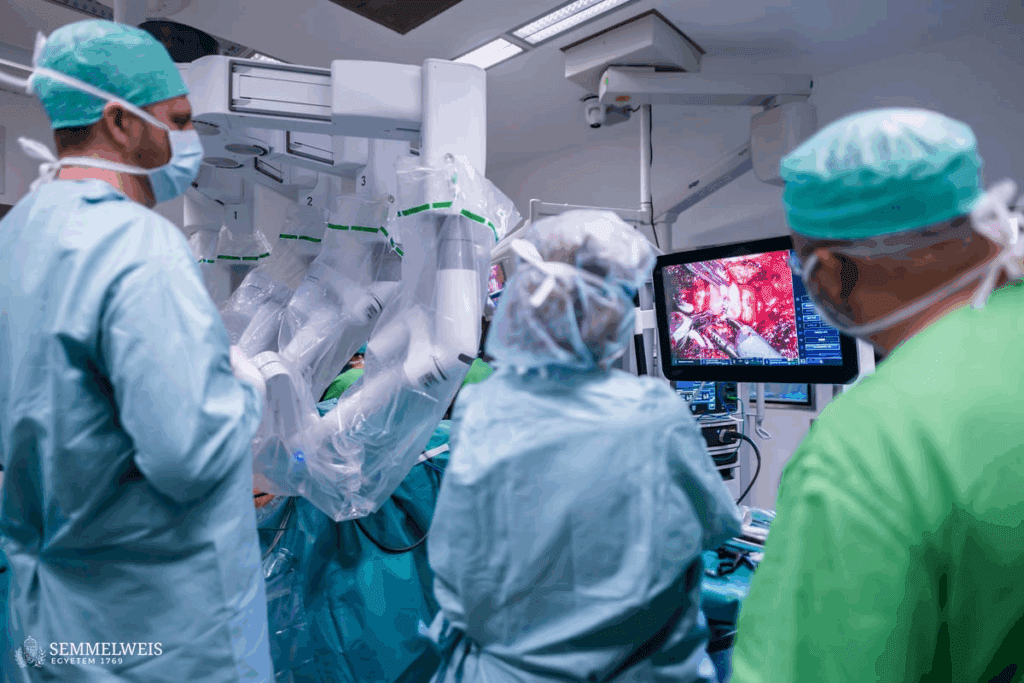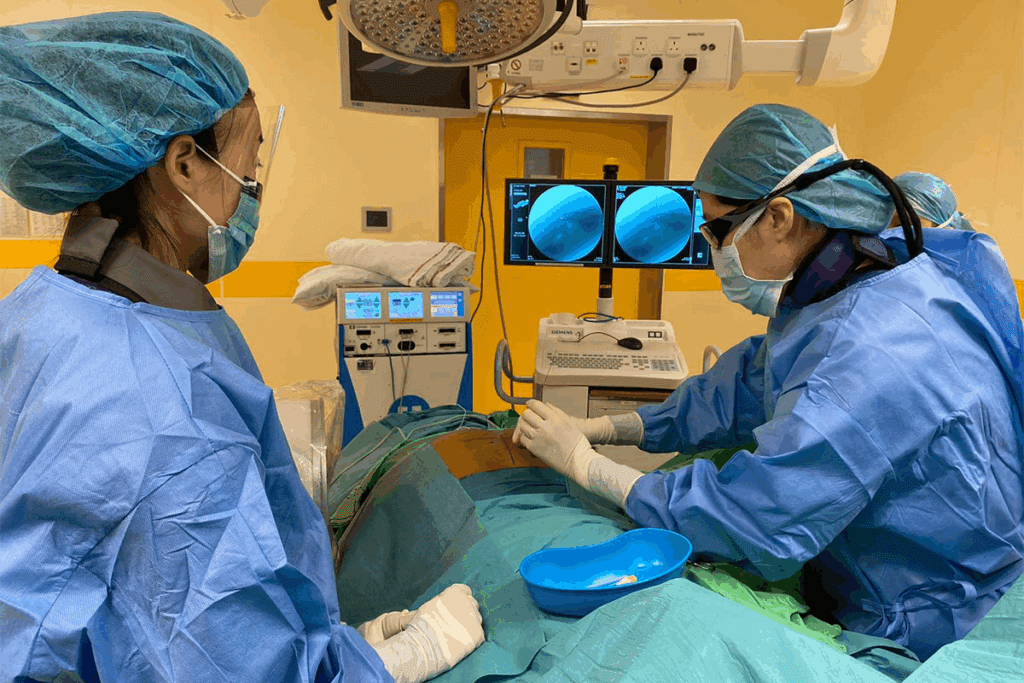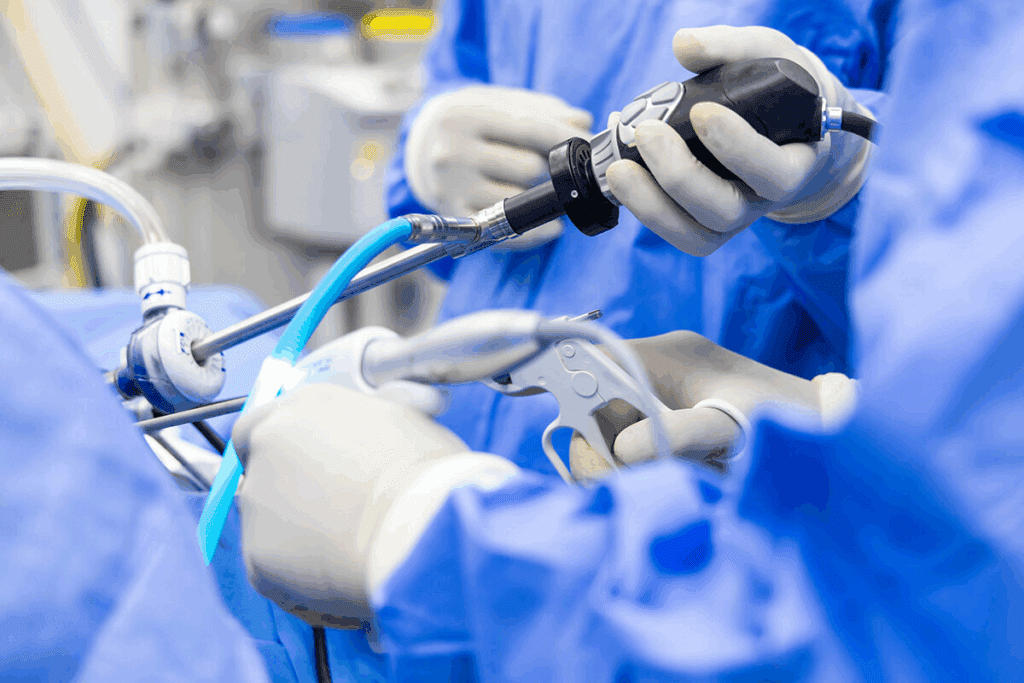Last Updated on November 27, 2025 by Bilal Hasdemir

Robotic surgery has changed urology for the better. It brings better views, precision, and skill to surgeries. This has made surgeries safer and less painful for patients.
The da vinci urologic procedures show how robotic tech is making minimally invasive urology better. Now, doctors can do complex surgeries with more accuracy. This makes robotic surgery a top choice for many urologists.

Urology surgery has changed a lot, moving from old open surgery to new robotic-assisted methods. This change aims to make patients better off, recover faster, and get more precise surgery.
Old urology surgeries used big cuts and took longer to heal. Laparoscopic surgery came along and changed things. It uses small cuts for a camera and tools, causing less damage.
Laparoscopic surgery cuts down on pain, hospital time, and scarring. But, it’s tricky because of limited tool control and two-dimensional views.
| Characteristics | Open Surgery | Laparoscopic Surgery |
| Incision Size | Large | Small |
| Recovery Time | Longer | Shorter |
| Postoperative Pain | More | Less |
Robotic surgery is great for surgeries like prostate and kidney removals. It’s all about being precise and not invasive. The urology robotic benefits include better accuracy, less blood loss, and quicker recovery.

Minimally invasive urology is a big step forward in surgery. It offers a gentler way compared to old-school open surgery.
This field uses new surgical methods that make cuts smaller. This results in reduced tissue damage and faster healing. The main ideas are:
These methods use cutting-edge tools and robotic systems. These systems help surgeons work more precisely.
Robotics has changed urological surgery for the better. Robotic urologic surgery gives surgeons better views and control. This makes complex surgeries easier to do.
Robotic surgery has made patients’ outcomes better. It has cut down on complications and sped up recovery. As robotics gets better, it will keep being a key part of urology.
The system has a surgeon’s console, a patient-side cart, and a vision system. The console gives a clear 3D view of the surgery area. This helps surgeons move and control with precision. The patient cart has robotic arms that follow the surgeon’s movements, making delicate work easier.
Key Features:
| Model | Key Features | Advantages |
| High-definition 3D vision, advanced instrumentation | Enhanced precision, flexibility | |
| Improved robotic arm design, enhanced visualization | Better access to surgical sites, reduced collisions | |
| Single-port surgery capability, enhanced ergonomics | Less invasive, improved patient outcomes |
Training Components:
Robotic technology has changed urology surgery for the better. It brings precision, flexibility, and less invasion to the table.
Robot-assisted radical prostatectomy (RARP) is now the top choice for prostate cancer surgery. It uses a robotic system for better vision and control.
Benefits of RARP include:
Robotic partial nephrectomy removes kidney tumors while keeping healthy tissue. It’s great for small tumors.
| Procedure | Benefits |
| Robotic Partial Nephrectomy | Preserves kidney function, reduces blood loss, and enables faster recovery |
| Robot-Assisted Prostatectomy | Enhances precision, reduces postoperative pain, and shortens hospital stay |
Robotic tech is used in more urology surgeries, like robotic cystectomy and pyeloplasty. These benefit from the precision and less invasion of robots.
The future of urology surgery looks bright with robotic tech. We can expect even more precise and less invasive surgeries.
Robotic surgery has changed urological operations for the better. It brings many benefits over old surgical methods. The use of robotic technology in urology has made surgeries more precise and controlled.
Robotic surgery offers enhanced surgical precision and control. It uses high-definition 3D visualization. This lets surgeons see and work on complex areas more accurately.
The robotic arms move like a surgeon’s hands. This gives surgeons the dexterity and precision they need.
This results in reduced tissue damage and faster healing.
Patients who have robotic surgery often stay in the hospital shorter stays than those who have open surgery. Robotic surgery is less invasive. This means less tissue damage, less pain, and a quicker recovery. Patients can go home sooner.
The faster recovery times of robotic surgery are a big plus for patients. The precision and reduced trauma of robotic surgery mean less pain after surgery. Patients can get back to their normal activities faster.
In summary, robotic surgery in urology has many benefits. These include better precision, less blood loss, shorter hospital stays, and quicker recovery. As robotic technology gets better, it will likely become even more important in urology.
Thanks to new robotic technology, high precision surgery is now possible. Robotic systems have changed urology by giving surgeons better views, precision, and control.
Enhanced Visualization: The 3D view is much better than old 2D systems. It helps surgeons see and work on complex areas more easily.
Robotic systems also have special features like tremor filtration and motion scaling. Tremor filtration gets rid of the shaking in a surgeon’s hands. Motion scaling lets surgeons make small, precise movements by scaling down their hand actions.
| Feature | Benefit |
| 3D Visualization | Enhanced view of the surgical site, improving accuracy |
| Tremor Filtration | Removal of natural hand tremors for steadier surgical actions |
| Motion Scaling | Precise movements through scaled-down hand motions |
These advanced technologies make robotic systems better for urological surgeries. They lead to better results for patients.
Robot-assisted radical prostatectomy (RARP) is now the top choice for prostate cancer surgery. It gives surgeons better vision and control.
The robot-assisted prostatectomy starts with small ports for the robotic arms. The surgeon uses a console to control these arms. This allows for precise removal of the prostate gland.
The robotic system’s 3D visualization and tremor filtration help the surgeon work accurately. This reduces damage to nearby tissues and nerves.
Research shows robot-assisted prostatectomy has many benefits. These include:
Studies show patients who have RARP face fewer problems and better results than those with traditional surgery.
Not every patient is right for robot-assisted prostatectomy. The right candidates are those with:
A urologist must carefully check each patient to see if robotic prostatectomy is the best option.
Robotic technology has changed urological surgery, making it less bloody. These systems are key in modern urology. They give surgeons better precision and control in complex surgeries.
The robotic system’s advanced technology is key in cutting down blood loss in surgeries. High-definition 3D imaging is a big help. It lets surgeons see and stop bleeding vessels better.
The robotic system also offers precision and dexterity. This means surgeons can do fine work without hurting nearby tissues. The system also removes hand tremors, making surgery more precise.
Robotic-assisted surgeries lead to less blood loss. This is good for both transfusion rates and patient recovery. Studies show patients have lower transfusion rates than those in traditional surgeries.
Less blood loss also means faster recovery times and fewer complications. Patients feel less pain and stay in the hospital less. This makes their recovery better.
Robotic systems make surgeries safer and lead to better patient outcomes. As technology gets better, its role in reducing bleeding and improving recovery will grow.
Robotic urology is changing surgery by making it less invasive. This leads to quicker recovery times for patients. Let’s explore how robotic urology benefits patients after surgery.
Robotic urology cuts down on post-surgery pain. The precision of robotic systems means less damage to tissues. This results in less pain for patients.
Patients need less pain medicine after robotic surgery. This lowers the chance of opioid addiction and its side effects.
A study showed robotic-assisted prostatectomy patients had less pain. They also needed less pain medicine than those who had open surgery.
Robotic urology also means patients can get back to normal faster. The small incisions and less blood loss help wounds heal quicker. This leads to faster recovery times.
Patients can start their daily activities again in just a few weeks. This is much sooner than with traditional open surgeries.
| Benefits | Robotic Urology | Traditional Surgery |
| Post-Operative Pain | Reduced | Higher |
| Analgesic Requirements | Lower | Higher |
| Return to Normal Activities | Faster | Slower |
Robotic urology offers more than just a quick surgery. It makes recovery smoother and more comfortable for patients. As technology advances, we can expect even better results for patients.
Robotic urology is growing, but we must understand its challenges to improve. It has changed urology by making surgeries more precise and recovery times shorter. Yet, it faces hurdles that must be overcome to reach its full promise.
One big challenge is the learning curve for using robotic systems. Teams need thorough training to handle the complex robotic procedures. This training is key for both surgeons and the whole operating room team.
Getting good at robotic surgery takes time. It can take from 20 to over 100 cases for a surgeon to feel confident. This depends on their experience with laparoscopic surgery and how well they adapt to the robotic system.
Robotic urology, like any surgery, has technical constraints and complications. Rarely, the robotic system can malfunction, which can affect the surgery. Also, problems like bleeding or injury to nearby tissues can happen.
| Complication | Frequency | Management Strategy |
| Bleeding | Moderate | Enhanced hemostatic measures |
| Robotic system malfunction | Low | Regular maintenance and backup systems |
| Injury to surrounding tissues | Moderate | Improved surgical technique and training |
Another big issue is accessibility and availability. Robotic systems are pricey, making them hard for many hospitals to afford. Even where they exist, finding trained surgeons and staff can be tough.
This problem means some patients face long waits or must travel far for robotic surgery. To fix this, we need to train more surgeons and make robotic systems more available in hospitals.
Robotic urology is changing healthcare worldwide. It has improved patient care but also brought new costs. Healthcare providers must now think about these economic changes.
Running costs are also important. These include the cost of parts, energy use, and the need for updates. Hospitals must think about these costs when deciding to use robotic urology.
Robotic urology has long-term benefits. It can lead to shorter hospital stays and quicker recovery. This saves money for both healthcare and patients.
It also makes surgeries more precise and effective. This might mean fewer follow-up treatments. This makes robotic urology more cost-effective in the long run.
Looking at long-term benefits is key. This includes better patient outcomes and fewer readmissions. By comparing these benefits to the costs, healthcare can make smart choices about robotic urology.
Robotic urology is on the verge of a big change. New multiport robotic systems and artificial intelligence are coming. These advancements will greatly impact the field.
New multiport robotic systems are being developed. They offer better flexibility and dexterity. This means surgeons can do more complex surgeries with ease.
The latest robotic systems have better articulation and visualization. This allows for more precise surgeries. Surgeons can now perform detailed procedures with higher accuracy.
Single-port robotic systems are also emerging. They aim to make urological procedures less invasive. These systems are in the early stages but show promising results.
Artificial intelligence (AI) and machine learning (ML) are key for robotic urology’s future. AI and ML can analyze data in real-time during surgeries. They provide valuable support to surgeons.
AI can identify anatomical structures and predict complications. This helps surgeons make better decisions. ML can also help create personalized surgical plans. This could lead to better patient outcomes.
The future of robotic urology looks bright. Advancements in these technologies will lead to more precise and personalized care.
Robotic systems have changed urology, making surgeries more precise and less bloody. They help patients recover faster. This new technology has greatly improved how we care for urological issues.
Robotic urology is getting even better with new tech like artificial intelligence and machine learning. These advancements will make surgeries even more precise and care better for patients. The impact of robotics on urology is huge, and it will keep changing the future of surgery.
Robotic surgery in urology uses robotic systems like the da Vinci Surgical System. It helps perform minimally invasive urological procedures with better precision and control.
Robotic surgery makes urological operations better by giving surgeons more precision and control. It also reduces blood loss, leading to shorter hospital stays and faster recovery times.
Robot-assisted prostatectomy, or prostat robot cerrahisi, has many benefits. It reduces blood loss, lowers postoperative pain, and speeds up recovery times. These are advantages over traditional open or laparoscopic methods.
Robotics improves surgical accuracy with 3D visualization systems, tremor filtration, and motion scaling. This allows surgeons to do complex procedures with more precision and control.
Robotic urology offers post-operative benefits like reduced pain and less need for pain medication. It also means patients can return to normal activities sooner. This leads to better patient outcomes and satisfaction.
Robotic urology faces challenges like a learning curve for surgical teams and technical constraints. There are also issues with accessibility and availability. These can affect the widespread use of robotic technology.
The future of robotic urology looks promising with emerging technologies and platforms. It will also involve artificial intelligence and machine learning. These advancements will continue to improve patient care.
Robotic surgery reduces blood loss by using precise dissection and hemostatic techniques. This results in lower transfusion rates and better patient outcomes.
The cost of robotic urology includes The costs associated with initial investments and ongoing operations. But, there are long-term economic benefits like reduced hospital stays and improved patient outcomes.
Subscribe to our e-newsletter to stay informed about the latest innovations in the world of health and exclusive offers!